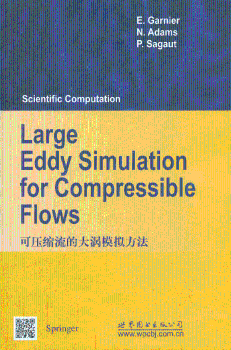内容简介
可压缩流的les是一个函待开发的领域,《可压缩流的大涡模拟方法》旨在讲述les基础及其在实践中的应用。为了程度地缩小理论框架之间的衔接,缓解les研究和日益增长的工程模型应用中的需求之间的矛盾,《可压缩流的大涡模拟方法》程度地将和该领域有关论题囊括其中,用全新的方式全面讲述了les理论及其应用。
目录
1 Introduction
2 LES Governing Equations
2.1 Preliminary Discussion
2.2 Governing Equations
2.2.1 Fundamental Assumptions
2.2.2 Conservative Formulation
2.2.3 Alternative Formulations
2.3 Filtering Operator
2.3.1 Definition
2.3.2 Discrete Representation of Filters
2.3.3 Filtering of Discontinuities
2.3.4 Filter Associated to the Numerical Method
2.3.5 Commutation Error
2.3.6 Favre Filtering
2.3.7 Summary of the Different Type of Filters
2.4 Formulation of the Filtered Governing Equations
2.4.1 Enthalpy Formulation
2.4.2 Temperature Formulation
2.4.3 Pressure Formulation
2.4.4 Entropy Formulation
2.4.5 Filtered Total Energy Equations
2.4.6 Momentum Equations
2.4.7 Simplifying Assumptions
2.5 Additional Relations for LES of Compressible Flows ..
2.5.1 Preservation of Original Symmetries
2.5.2 Discontinuity Jump Relations for LES
2.5.3 Second Law of Thermodynamics
2.6 Model Construction
2.6.1 Basic Hypothesis
2.6.2 Modeling Strategies
E. Gamier et al., Large Eddy Simulation for Compressible Flows,
Scientific Computation,
Springer Science + Business Media B.V. 2009
3 Compressible Turbulence Dynamics
3.1 Scope and Content of This Chapter
3.2 Kovasznay Decomposition of Turbulent Fluctuations
3.2.1 Kovasznay's Linear Decomposition
3.2.2 Weakly Nonlinear Kovasznay Decomposition
3.3 Statistical Description of Compressible Turbulence
3.4 Shock-Turbulence Interaction
3.4.1 Introduction to the Linear InteractionApproximation Theory
3.4.2 Vortical Turbulence-Shock Interaction
3.4.3 Mixed-Mode Turbulence-Shock Interaction
3.4.4 Consequences for Subgrid Modeling
3.5 Different Regimes of Isotropic Compressible Turbulence
3.5.1 Quasi-Isentropic-Turbulence Regime
3.5.2 Nonlinear Subsonic Regime
3.5.3 Supersonic Regime
3.5.4 Consequences for Subgrid Modeling
4 Functional Modeling
4.1 Basis of Functional Modeling
4.1.1 Phenomenology of Scale Interactions
4.1.2 Basic Functional Modeling Hypothesis
4.2 SGS Viscosity
4.2.1 The Boussinesq Hypothesis
4.2.2 Smagorinsky Model
4.2.3 Structure Function Model
4.2.4 Mixed Scale Model
4.3 Isotropic Tensor Modeling
4.4 SGS Heat Flux
4.5 Modeling of the Subgrid Turbulent Dissipation Rate
4.6 Improvement of SGS models
4.6.1 Structural Sensors and Selective Models
4.6.2 Accentuation Technique and Filtered Models
4.6.3 High-Pass Filtered Eddy Viscosity
4.6.4 Wall-Adaptin




 VIP会员
VIP会员